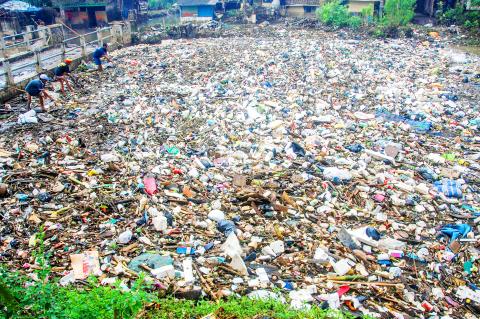The scabies on Indonesian rice farmer Yusuf Supriyadi’s limbs are a daily reminder of the costs of living next to the “world’s dirtiest river.”
Supriyadi depends on the Citarum River’s murky waters — a floating carpet of household garbage, toxic chemicals and animal feces — to irrigate a small rice plot in West Java Province that sustains his family of six.
The farmer’s rice yield is now down by two-thirds in the rainy season as textile factories dump increasing amounts of industrial waste into the river, but he has few other options.

Photo: AFP
“There are floods during the rainy season. My hands get itchy and the harvest is damaged,” the 54-year-old told Agence France-Presse. “Pollution makes my rice hollow. If I keep going I’ll lose money, but if I don’t, I’ll have no other job.”
Now faced with a health emergency after decades of failed cleanup efforts, Jakarta is stepping in with a seemingly impossible goal: make the Citarum’s water drinkable by 2025.
Using this polluted water is a risky calculation for many of the 30 million people who rely on it for irrigation, washing and even drinking water — including about 80 percent of residents in the sprawling capital, Jakarta.
At nearly 300km long, the river is also a key source for hydroelectric power for Indonesia’s most populated island, Java, and tourism hot spot Bali.
The World Bank declared it the most polluted river in the world a decade ago, a description widely picked up by media and environmentalists.
Waste levels can vary depending on how pollution is measured and the time of the year, but the Citarum is dangerous by almost any standard.
Previous research has shown it has alarming levels of toxic chemicals — including 1,000 times more lead than the US standard for safe drinking water.
It regularly appears on most polluted lists alongside India’s Ganges River, the US’ Mississippi River and China’s Yellow River.
In January, Jakarta yanked responsibility away from local governments and vowed to get tough on business owners who ignore waste disposal rules. Factories that fall short could have operating permits revoked.
CCTV cameras are to be installed along the river’s banks to keep an eye out for offenders dumping waste in the early morning hours to evade detection.
Meanwhile, dredging equipment is to be used to clean up the filthy river, Indonesian Ministry of Maritime Affairs and Fisheries spokesman Djoko Hartoyo said.
“We are not playing around this time,” he said. “We’re going in with a holistic approach, so we are optimistic we can make Citarum clean again, just like it was 50 or 60 years ago.”
In the 1980s, a new industrial zone sprang up around the small town of Majalaya, about 170km east of Jakarta, and things quickly changed for the pristine river.
About 2,000 textile factories in the area have provided much-needed jobs, but they came with a heavy cost: About 280 tonnes of industrial waste are dumped into the river each day, government and environmental group data showed.
Making matters worse, many locals think nothing of tossing their household waste into its toxic waters.
“When it rains and my house gets flooded, the smell is awful,” Achmad Fachrureza said from inside an inflatable dingy as he navigated the river’s polystyrene foam containers, fabric, empty cans, plastic bottles and garbage bags.
The 57-year-old villager said he was fired from his job as a textile factory security guard after asking questions about the firm’s waste disposal system.
Factory pipes dump waste directly into waters bubbling with chemical dyes used in textiles, creating an overwhelming stench.
“Most factories here have a waste disposal system, but they don’t work properly, because it’s just a formality,” said Deni Riswandani of Elingan, a local environmental group.
That poses a serious health risk, especially for the 5 million people living in the river’s basin. Many locals suffer from skin diseases such as scabies and dermatitis, as well as respiratory infections from inhaling factory pollution.
“The number of people going to the health clinic is very high,” Riswandani said. “We keep reporting these issues to the government, but we never get a solution.”
He and other frustrated activists have blocked some waste pipes with rocks and concrete, but the factories usually remove the blockage right away.
Locals hope Jakarta’s new goals can be achieved, but they are also skeptical given the scale of the task and endemic corruption that could see factory owners try to buy their way out of trouble.
“I long to see the Citarum like it was when I was young,” Fachrureza said. “I could swim in it and drink the water. It was so clean.”

PERSISTENT RUMORS: Nvidia’s CEO said the firm is not in talks to sell AI chips to China, but he would welcome a change in US policy barring the activity Nvidia Corp CEO Jensen Huang (黃仁勳) said his company is not in discussions to sell its Blackwell artificial intelligence (AI) chips to Chinese firms, waving off speculation it is trying to engineer a return to the world’s largest semiconductor market. Huang, who arrived in Taiwan yesterday ahead of meetings with longtime partner Taiwan Semiconductor Manufacturing Co (TSMC, 台積電), took the opportunity to clarify recent comments about the US-China AI race. The Nvidia head caused a stir in an interview this week with the Financial Times, in which he was quoted as saying “China will win” the AI race. Huang yesterday said

Nissan Motor Co has agreed to sell its global headquarters in Yokohama for ¥97 billion (US$630 million) to a group sponsored by Taiwanese autoparts maker Minth Group (敏實集團), as the struggling automaker seeks to shore up its financial position. The acquisition is led by a special purchase company managed by KJR Management Ltd, a Japanese real-estate unit of private equity giant KKR & Co, people familiar with the matter said. KJR said it would act as asset manager together with Mizuho Real Estate Management Co. Nissan is undergoing a broad cost-cutting campaign by eliminating jobs and shuttering plants as it grapples

The Chinese government has issued guidance requiring new data center projects that have received any state funds to only use domestically made artificial intelligence (AI) chips, two sources familiar with the matter told Reuters. In recent weeks, Chinese regulatory authorities have ordered such data centers that are less than 30 percent complete to remove all installed foreign chips, or cancel plans to purchase them, while projects in a more advanced stage would be decided on a case-by-case basis, the sources said. The move could represent one of China’s most aggressive steps yet to eliminate foreign technology from its critical infrastructure amid a

MORE WEIGHT: The national weighting was raised in one index while holding steady in two others, while several companies rose or fell in prominence MSCI Inc, a global index provider, has raised Taiwan’s weighting in one of its major indices and left the country’s weighting unchanged in two other indices after a regular index review. In a statement released on Thursday, MSCI said it has upgraded Taiwan’s weighting in the MSCI All-Country World Index by 0.02 percentage points to 2.25 percent, while maintaining the weighting in the MSCI Emerging Markets Index, the most closely watched by foreign institutional investors, at 20.46 percent. Additionally, the index provider has left Taiwan’s weighting in the MSCI All-Country Asia ex-Japan Index unchanged at 23.15 percent. The latest index adjustments are to